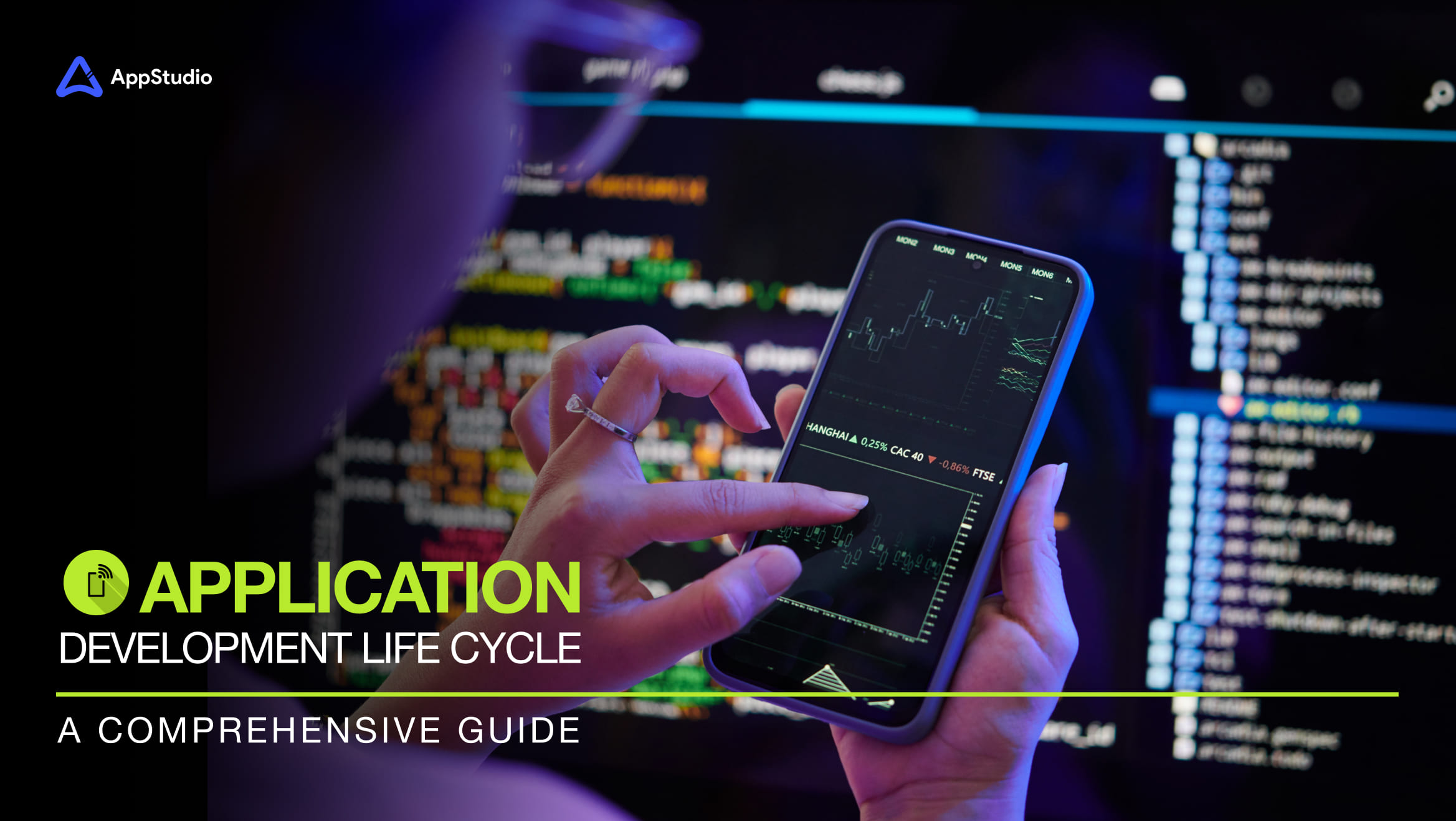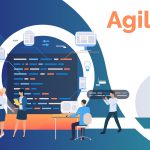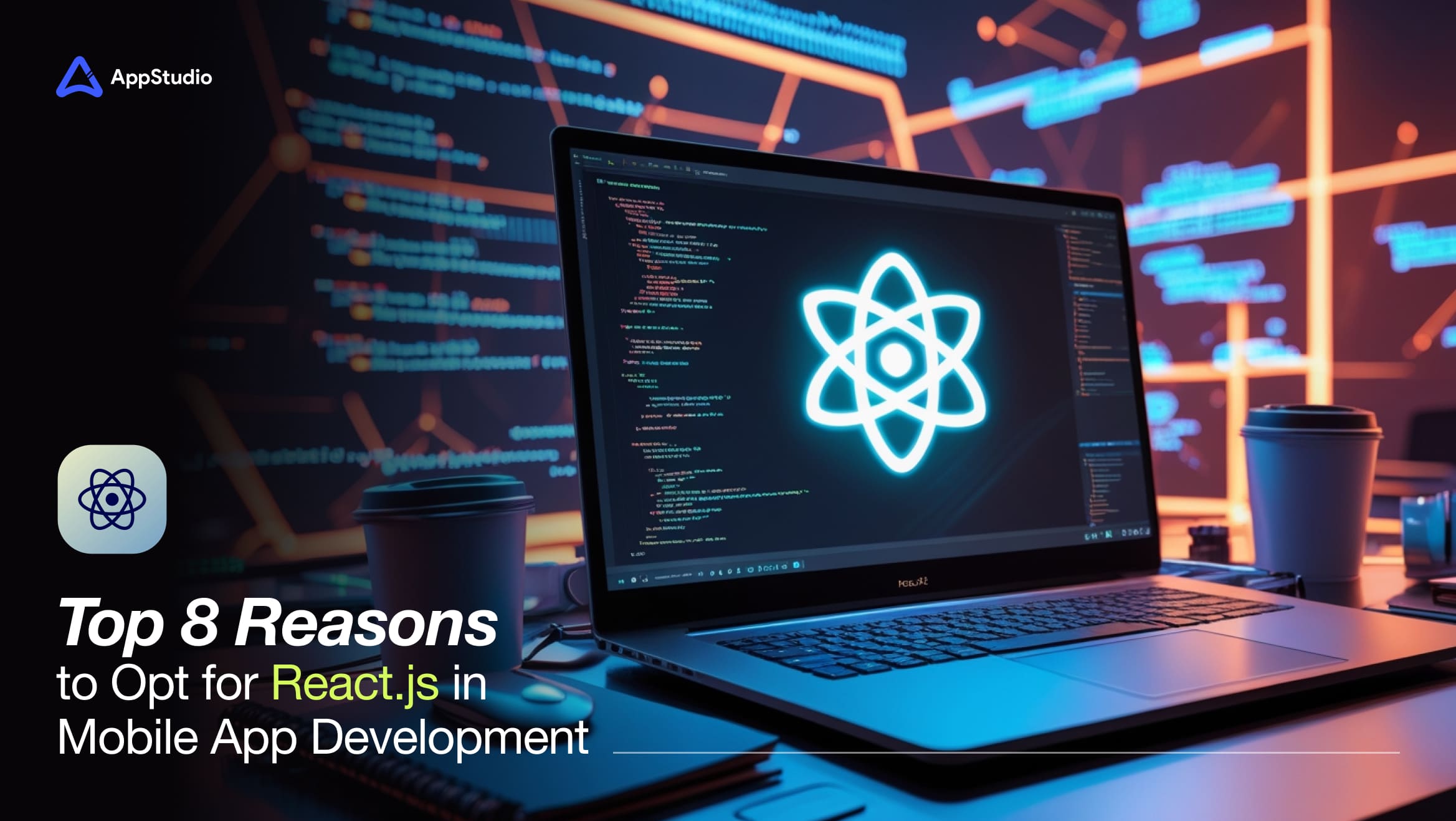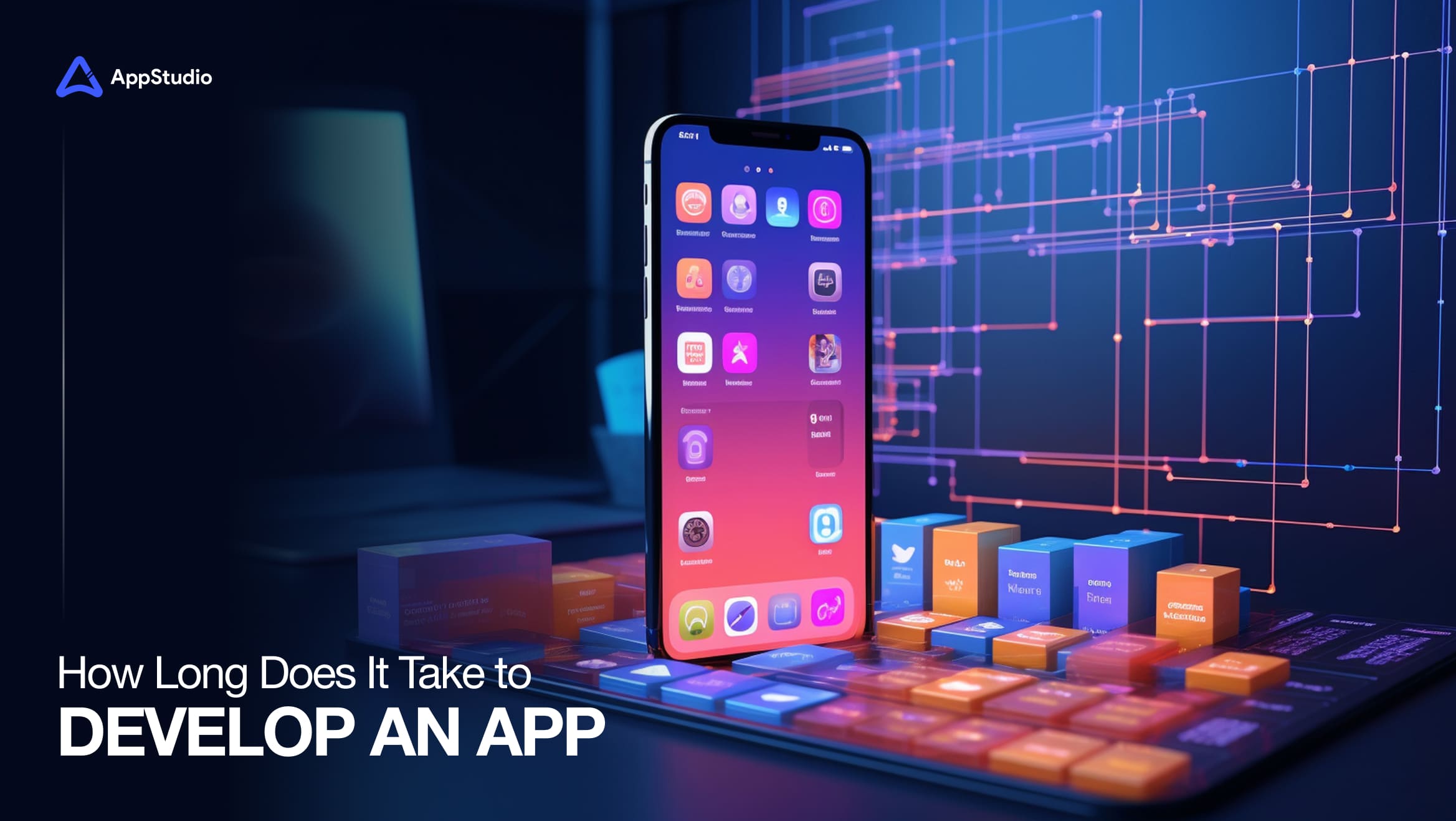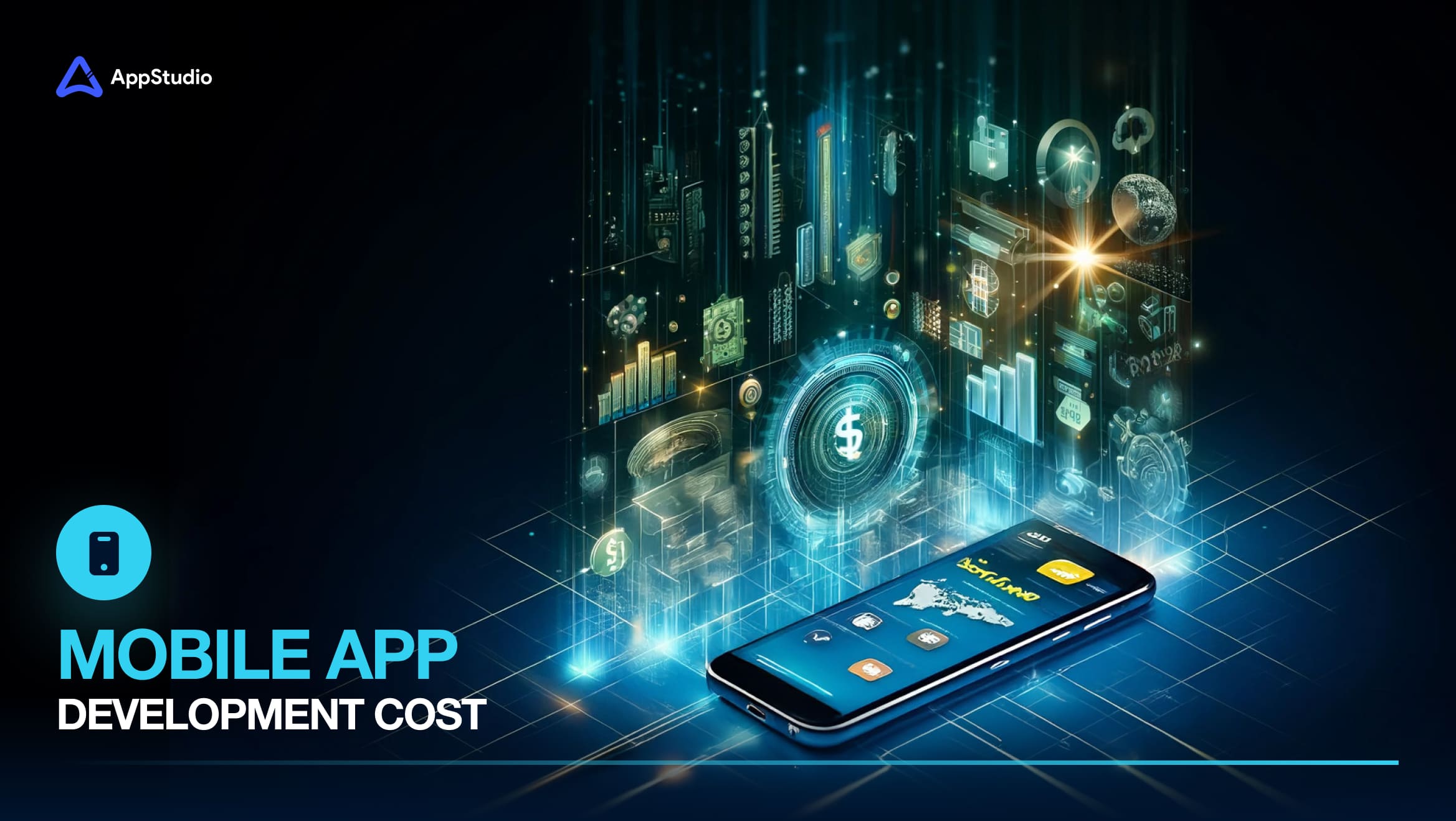Have you ever marveled at the magic behind the apps on your phone? How are they seamlessly integrated and always poised to cater to your needs? This could spark curiosity about the brains and technology that make these digital dreams a reality. In today’s world, apps have transcended their role as tools just for the tech-savvy; they’re now indispensable for every business, enhancing operations, boosting marketing efforts, and fostering customer loyalty.
Developing an app involves several critical steps, which are influenced by factors like the app’s specific requirements, project size, developers’ expertise, potential future updates, and the completion timeline. Although there’s no one-size-fits-all approach, development teams typically adhere to a common set of stages known as the application development life cycle. This structured methodology keeps the process organized, sets clear expectations, minimizes errors, and ensures that the final product is within budget and meets quality standards.
Understanding the application development life cycle is vital for businesses aiming to create apps that remain relevant and meet evolving user needs. This knowledge is crucial for developing well-functioning applications that fulfill their intended purpose effectively.
According to a Statista report, the application development software market is expected to reach USD 179.90 billion in 2024 and grow annually by 6.87%, reaching USD 234.70 billion by 2028. This growth highlights the importance of a well-defined development life cycle in the thriving app market. As most smartphone users rely heavily on apps for daily tasks, social connections, and entertainment, a well-designed app is essential for business success.
This blog will cover the essentials of crafting apps through a systematic approach to the mobile application development life cycle, aligning with the latest market trends and technologies. This foundation will streamline the app development process and enhance your app’s engagement and retention capabilities.
Related reading: 14 Easy Steps to Create an App
What is an Application Development Life Cycle?
The application development life cycle (ADLC) is a comprehensive framework that guides the entire process of an app’s creation, from initial planning and development to testing, deployment, and ongoing maintenance. This methodology, often referred to as full life cycle application development, aids developers in navigating the development process efficiently, cost-effectively, and swiftly, ensuring the delivery of superior apps.
The specific steps involved in the life cycle of application development may differ based on the latest trends and the unique demands of the app, such as integrating artificial intelligence, the nature of the business, and client needs. By accommodating these dynamic requirements, the full life cycle of application development ensures that the final product not only meets but often surpasses user expectations, providing an exceptional user experience. This adaptability within the life cycle of application development is critical in developing effective and innovative applications.
6 Key Stages of the App Development Life Cycle
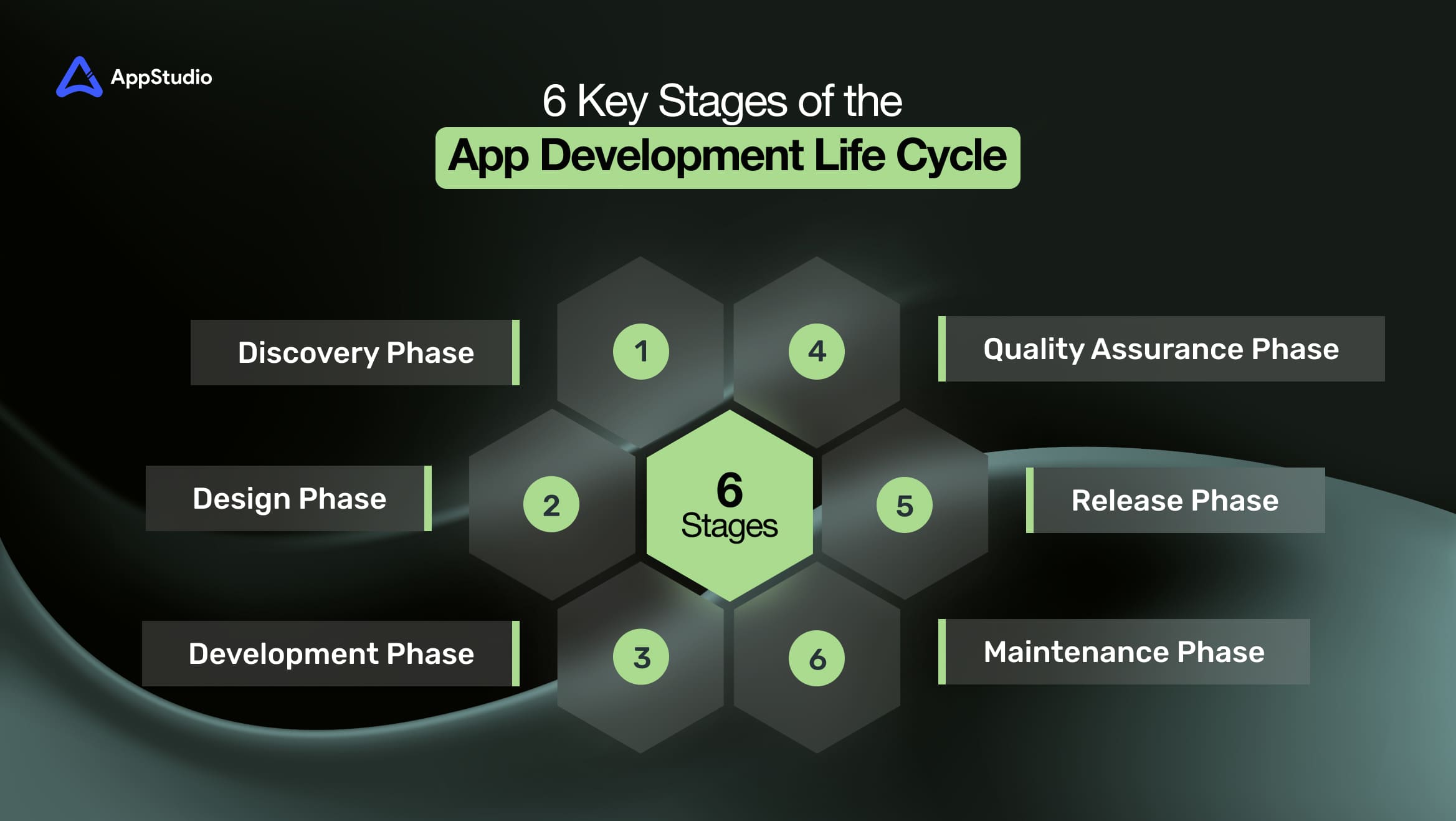
Discovery Phase
Even if you think you know exactly what your project needs, the initial discussions with your developers often unearth deeper questions: What user permissions are needed? Which operating systems should be supported? What screen resolutions are you targeting? This phase transforms your ideas into technical blueprints. Key activities in the discovery phase include:
- Mapping out features
- Defining technical requirements
- Analyzing competitors
- Estimating costs
- Setting deadlines
Design Phase
This phase shapes the visual identity of your project. Designers follow these steps to ensure your app is both unique and intuitive:
- Sketch: Designers first draft the basic concept of the app.
- Wireframe: This involves creating a detailed black-and-white layout of each screen, outlining the placement of all elements.
- Prototype: The final step is a clickable model of the app that simulates user interaction but lacks backend functionality.
Development Phase
With the design set, developers build the functional aspects of the app, divided into:
- Front-End Development: Here, app developers create the user interface, ensuring it is engaging and easy to navigate.
- Back-End Development: Often considered the backbone of the app, this handles the data processing, operations, and overall performance.
Quality Assurance Phase
Skipping this phase is like skipping proofreading a written piece—it’s essential to test the app thoroughly, both automatically and manually, to catch and fix any issues early. This step addresses potential risks and optimizes the app’s functionality before launch.
Release Phase
Now, the app is ready to be launched to the public or deployed within a company for internal use. This step is crucial for transitioning from development to real-world use.
Maintenance Phase
Post-launch, the app is continuously improved with updates that enhance functionality and user experience. Developers remain on hand to provide technical support and address any issues that arise, ensuring the app remains current and effective.
This structured approach, encapsulating the mobile application development life cycle phases, ensures that each stage of app development is handled with precision, paving the way for successful app deployment and operation. Understanding the phases of the application development life cycle and the definition of the mobile application development life cycle is essential for any team looking for app creation.
Related reading: How Long Does it Take to Develop an App
Overview of Application Development Life Cycle Models
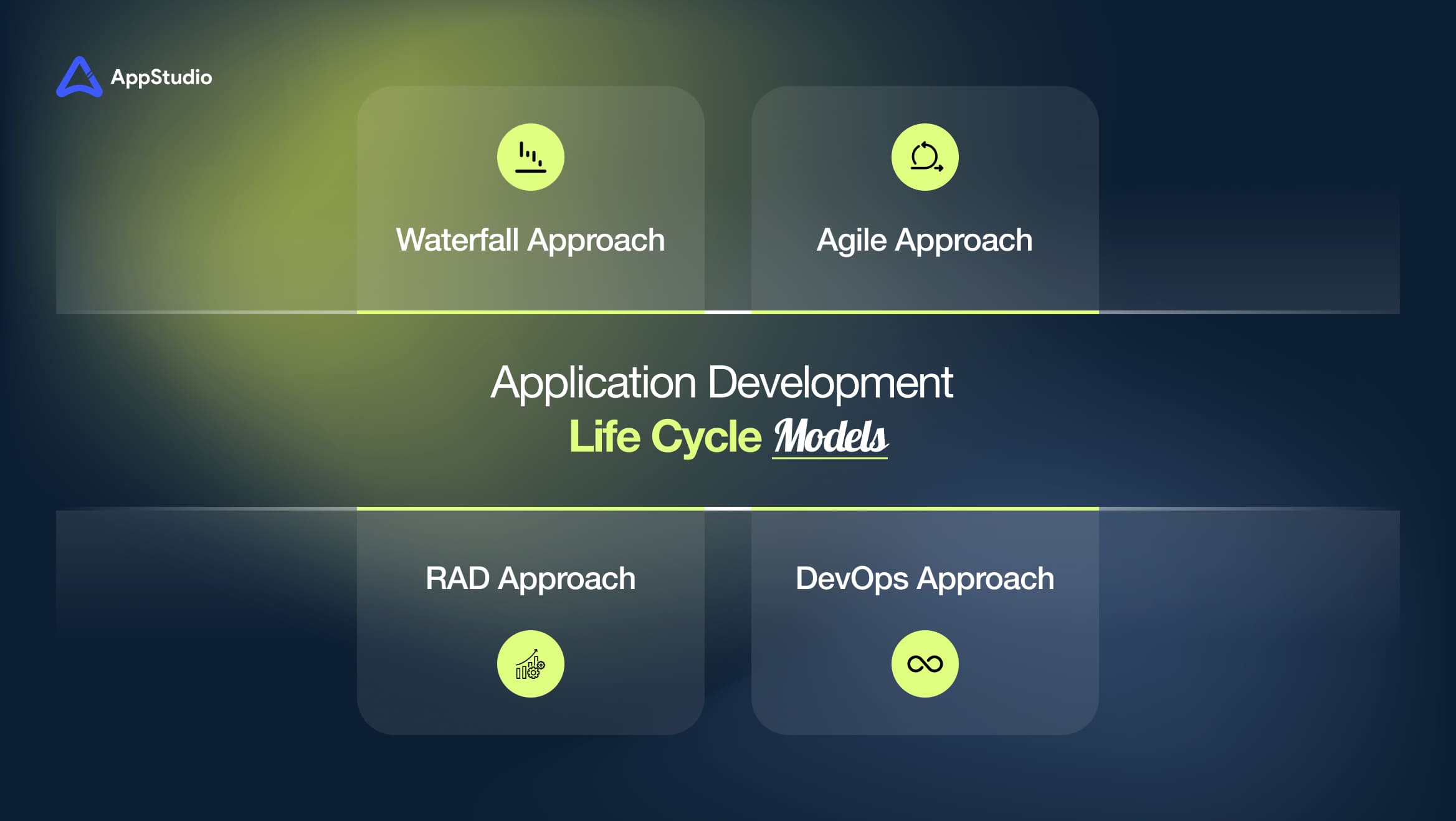
Waterfall Approach
The Waterfall model emphasizes meticulous planning and a sequential design process. It is termed “Waterfall” because, like a waterfall, the process is linear, and once a phase is completed, you cannot go back. This method involves a thorough collaboration among team members who develop the application strictly according to the pre-defined requirements over a specific timeline. This traditional model is a cornerstone in the application development life cycle stages.
Ideal for Waterfall:
- Projects with no anticipated changes
- Projects with tight budget constraints
- Projects similar to past endeavors
- Scenarios where the client has clear requirements and minimal involvement until the project’s completion
RAD Approach (Rapid Application Development)
In response to the Waterfall model’s limitations, RAD focuses on quick development cycles and frequent revisions. This approach heavily relies on prototyping and iterative testing to develop a working model swiftly. In RAD, small teams of skilled developers work closely with clients to ensure the application meets their needs.
Ideal for RAD:
- Projects that involve experienced developers
- Highly engaged clients
- Projects with flexible deadlines
- Projects addressing critical business needs
Agile Approach
While similar to RAD, Agile development is better suited for larger projects that require continuous integration and flexibility. Agile breaks down the development process into sprints—fixed periods during which specific features are developed, tested, and delivered. This model facilitates a highly collaborative environment and allows frequent reassessment and adjustments throughout the application development life cycle phases.
Ideal for Agile:
- Projects that can be segmented into distinct sprints
- Teams that are collaborative and have expertise in Agile methodologies
- Well-defined projects that allow for planned progress
- Availability of skilled project managers
DevOps Approach
As a relatively new entrant in the ADLC methodologies, DevOps merges development and operations teams to enhance the quality and speed of application delivery. This approach focuses on continuous improvement, rapid feedback, and the automation of manual processes, with frequent, minor updates being a hallmark.
Ideal for DevOps:
- Projects requiring a quick turnaround
- Teams with diverse skills and roles
- Situations that demand minimal system downtime
- Projects that need to quickly adapt based on user feedback
Each model offers different benefits and suits various project types and business environments. Choosing the right approach depends on your project requirements, team composition, timelines, and stakeholders’ desired level of involvement.
Related reading: How much Does it Cost to build an App
Key Tools for Effective Mobile App Development Lifecycle Management
- Version Control Systems: Systems such as Git, SVN, and Mercurial facilitate code collaboration, enabling simultaneous development, change tracking, and preservation of code integrity.
- Documentation Tools: Tools like Confluence, DokuWiki, and Read the Docs support the development, organization, and sharing of project documentation, user guides, and API documentation, equipped with capabilities such as rich text editing, version control, and access management.
- CI/CD Tools: Tools such as Jenkins, CircleCI, and GitLab CI/CD automate the processes of building, testing, and deploying apps, featuring automated tests, deployment pipelines, and rollback features to ensure quick and reliable releases.
- Issue Tracking Systems: Applications like Bugzilla, Redmine, and Mantis are instrumental in tracking and resolving software bugs and issues, helping teams prioritize and address problems swiftly to prevent delays in project timelines.
- Project Management Platforms: Solutions like Jira, Trello, and Asana offer agile workflows and customizable boards for effective planning, resource management, and monitoring progress.
- Collaboration Tools: Platforms like Slack, Microsoft Teams, and Zoom promote real-time communication among team members, aiding seamless collaboration regardless of their geographic locations.
6 Benefits of the Mobile App Development Lifecycle
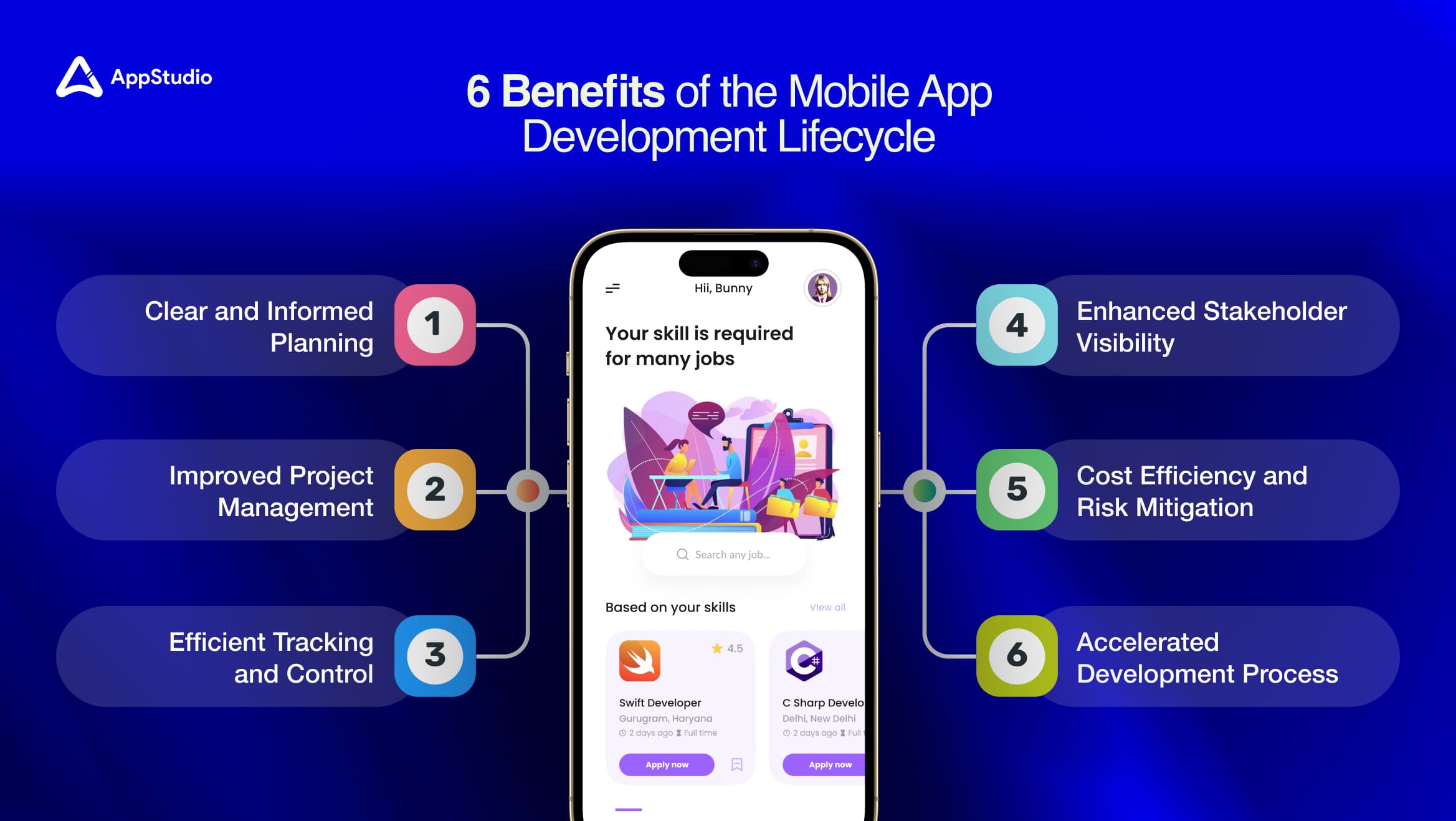
Clear and Informed Planning
This lifecycle provides a detailed roadmap of the application development life cycle stages, enabling organizations to set realistic timelines and ensure that all specifications are understood and met efficiently.
Improved Project Management
By offering a comprehensive view of the application development life cycle, the lifecycle enhances the ability of team leaders to manage and schedule app development more effectively.
Efficient Tracking and Control
The structured application development life cycle phases make monitoring progress and managing the various aspects of app development easier, ensuring timely releases and client satisfaction.
Enhanced Stakeholder Visibility
A standardized framework during app development ensures that every phase and its outcomes are visible to all involved parties, enhancing transparency and communication.
Cost Efficiency and Risk Mitigation
Following a predefined application development life cycle helps reduce costs by avoiding unnecessary steps and mitigating risks associated with ad-hoc development strategies.
Accelerated Development Process
The application development life cycle facilitates a quicker route from concept to deployment by anticipating and eliminating common development obstacles through planned timelines.
Adhering to a mobile app development lifecycle not only streamlines production but also significantly enhances the quality and success of the final product.
Related reading: 20 Top Mobile App Development Tools
Key Quality Attributes of Application Development
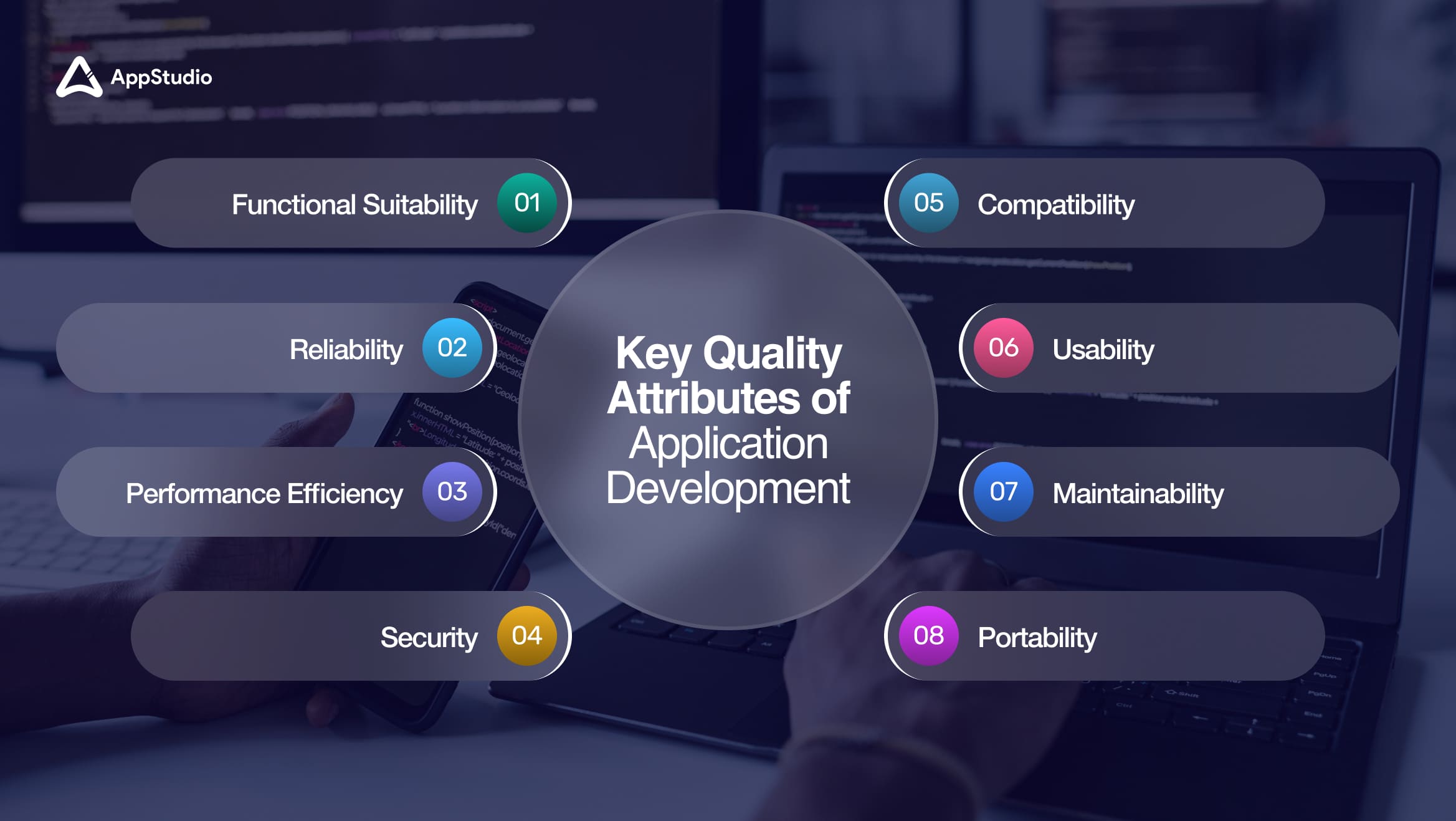
The ISO 25010 standard identifies eight essential quality characteristics that should be present in application software:
- Functional Suitability: The application should be functionally complete and appropriate, effectively fulfilling the specified requirements.
- Reliability: Applications must be dependable, which includes being accessible, fault-tolerant, and capable of quick recovery after failures.
- Performance Efficiency: Applications should manage timing and resource utilization efficiently to ensure optimal performance and capacity handling.
- Security: This involves protecting data integrity and confidentiality, ensuring secure authentication processes, and enabling safe administrative operations.
- Compatibility: The software should demonstrate a high degree of interoperability and co-existence with other systems, ensuring seamless integration.
- Usability: A quality application offers excellent usability, including easy-to-learn interfaces, aesthetically pleasing design, and safeguards against user errors, enhancing overall operability.
- Maintainability: Applications should be easy to update and maintain, thanks to a modular structure, reusability of components, and availability of effective analytic tools.
- Portability: Software needs to be installable, adaptable, and portable, facilitating easy deployment across various environments.
AppStudio: Your Trusted Partner for Next-Generation App Development
AppStudio is the perfect partner for your application development needs, blending expertise, innovation, and customer-focused solutions. We adhere to ISO 25010 standards to deliver apps that are not only functional but also robust and user-friendly.
Choosing AppStudio means more than just hiring a developer; it means partnering with a team committed to functional suitability. We take the time to understand your specific requirements thoroughly before beginning development, ensuring precision and comprehensiveness.
Our applications are reliable, accessible, and fault-tolerant, maintaining performance even in unforeseen circumstances. We prioritize performance efficiency, optimizing resource use for better capacity management and user satisfaction.
Security is paramount at AppStudio. We implement rigorous measures to protect your data at all operating levels, ensuring integrity and confidentiality. Additionally, our focus on usability, maintainability, and portability guarantees an application that’s easy to use across various platforms and devices.
Partner with AppStudio to transform your vision into a high-quality digital reality, ensuring your app is built to last and perform.
Related reading:What is The Mobile App Development Process?
Frequently Asked Questions
The ADLC is a structured framework that guides the creation of apps from planning and development to testing, deployment, and maintenance, ensuring efficient and quality software production.
It enhances project management, streamlines tracking, increases stakeholder visibility, reduces costs, mitigates risks, and speeds up the app development process.
AppStudio implements stringent security protocols, including data integrity, secure authentication processes, and safe administrative operations, to protect applications against vulnerabilities.
AppStudio prioritizes usability by designing intuitive interfaces that are easy to learn and use, incorporating aesthetic elements that reflect the brand, and preventing user errors, which enhances the overall user experience and satisfaction.
AppStudio is known for integrating rigorous quality standards with innovative solutions, ensuring that each app is functionally effective, robust, and user-friendly. They dedicate significant resources to understanding client needs thoroughly and maintaining high standards throughout the development process, making them a reliable choice for transformative digital projects.
Each phase in app development, from Discovery to Maintenance, plays a critical role in shaping the final product. The Discovery Phase defines the project’s scope, Design shapes its user experience, Development builds its functionality, Quality Assurance ensures its reliability, Release introduces it to users, and Maintenance keeps it relevant and effective over time, collectively guaranteeing a robust and well-rounded application.
